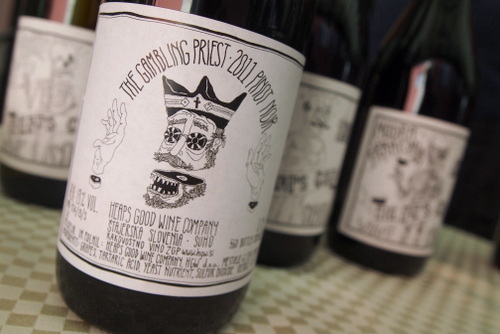What do I like in Pinot Noir? I look for a few things in a great Pinot. First of all, that indefinable quality of elegance. I wish I could define elegance in a wine, but I can’t. I know it when I see it, though.
I want to be charmed and seduced by a wine that has beauty. It can have power, but that power has to be reined in and balanced by subtlety, too.
I look for detail. I don’t just want a wall of sweet fruit, but I want there to be details in the wine: points of interest. Complexity, I guess.
Texture is so important. Pinot Noir should have a smooth mouthfeel, and a bit of mid-palate weight. I have heard it suggested that one of the effects of Brettanomyces (the spoilage yeast that affects too many red wines) is to use up the little bit of sugar left after fermentation that Saccharomyces cerevisiae (the main wine yeast) can’t metabolize. This trace of sugar helps give texture, and when it is stripped out, Pinot Noir suffers. This is aside from the sensory impact of Brettanomyces. Brett is a disaster in Pinot Noir, and so I prefer not to have any, even though some people like the way it makes a wine more savoury.
Definition and freshness are important in Pinot. There needs to be a brightness to the wine.
Non-fruit complexity is important. Fruit alone is not enough to make a truly compelling wine. But that non-fruit character needs to be appropriate: you don’t want your Pinot to be angular or rustic.
I don’t like noticeable new oak in Pinot Noir, especially when it gives that spicy, roast coffee character. It removes elegance.
In terms of fruit, I like fresh, bright fruit characters, not over-ripe jammy ones.
In terms of colour, I would rather not have a deep coloured Pinot. Pale colour can be a good thing. One of Pinot’s virtues is that it can be pale-coloured, light bodied, and yet complex, full, aromatic and ethereal.
I love perfumed Pinots, especially when fruit characters are joined by floral and even subtle meaty notes.
Although my preference is for more elegant, lighter Pinots, sometimes big ones can work well. So I am open minded. Rich Pinot can taste like cool-climate Syrah, and I love cool-climate Syrah. Lighter, very cool-climate Syrah shares a resemblance with Pinot Noir. The two seem to have something in common.
It is all about balance. The wine is a whole. And it’s really difficult to write tasting notes that are holistic rather than reductionist in nature. A list of exotic fruits and spices is no use at all. That’s why the use of metaphor and even metonymy is important in describing wine.
5 Comments on What do I look for in Pinot Noir?
Very precise description of Pinot Noir. I would venture to say this is not merely a personal preference but captures a reasonably wide consensus regarding what Pinot Noir should taste like. (with of course lots of dissenters.
And a succinct characterization of the problem with tasting notes.
I have nowhere near your tasting experience, Jamie, so I find it difficult to differentiate the description of PN above from a description of Merlot or Sangiovese. It’s difficult to render the experience precisely in words, which is why many tasting notes are lists. Lists provide multiple points of entry for people with vastly different levels of tasting experience and flavor memory.
Personally, I share your global preferences for PN with fruit that sits (“elegantly”) between red and blue berry-like flavors and supported by fine tannins, medium mid-palate density, and medium levels of acidity. It doesn’t feel reductive to me to try to itemize such things.
To me, there are three berry poles. The red berry flavors — cranberry, raspberry, red currant — predominate (to me) in Sangiovese, which also has more acid. Good Pinot Noir blends into the red berries a little black current and blueberry, and has less acid. It has less blueberry fruit than, say, Merlot or (especially) Petite Syrah, which is the second berry pole. The third pole is the black fruit flavor — blackberries, plums, black currants and maybe dark bing cherries — what I think of as the Cabernet Sauvignon, Grenache, Nebbiolo angle.
It helps me to rough out where a red wine sits between these poles. And of course on top sit the aromatics: tar, roses, menthol, leather, chocolate, grassy spice, etc. And much more.
Have you ever read descriptions of perfume? There’s a similar tension in perfume descriptions between constituent aroma listiness and holistic impressionistic metaphor.
Both have legitimate purposes.
Hi Jamie,
That is indeed a very precise a description of Pinot Noir. The following passage particularly reminds me of Hanspeter Ziereisen in Germany who makes both Pinot Noir and Syrah:
“So I am open minded. Rich Pinot can taste like cool-climate Syrah, and I love cool-climate Syrah. Lighter, very cool-climate Syrah shares a resemblance with Pinot Noir. The two seem to have something in common.”
As an aside:
I do like reading your blog and appreciate that it’s your forum and you can write what you like in it. However, I often think you give scant coverage in to Germany, given the country’s significant contribution to fine wine and the recent (and belated) rise in coverage of German wines among your fellow UK wine writers.
Best wishes,
Simon
Please excuse the typos in the previous comment.
Hi Jamie,
I’d also like to throw in a further aspect. Something normally hidden by the tannin structure. It’s the salty mineralic components of Pinot Noir.
Anthony describes the possible berry flavour profiles very nicely. NZ Pinots used to follow the dark black berry flavours turning nowadays towards the red berry flavours.
It’s always fun playing with different ripeness levels to reach the certain berry style… but one important aspect is also the type of clone you are using.
Best regards
Patrick